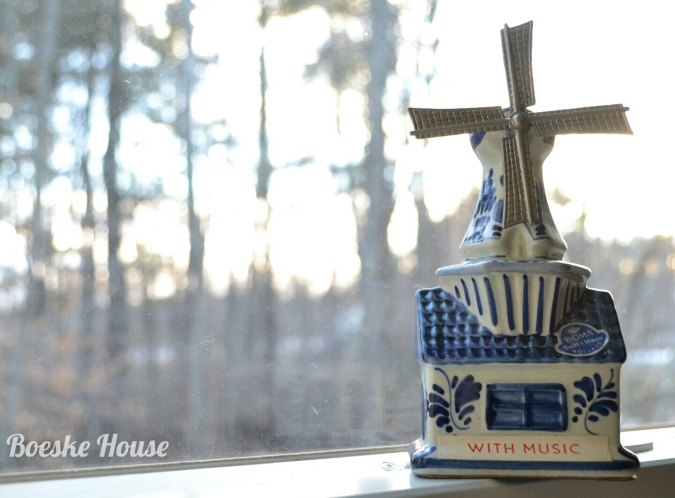As readers of my last post know – Saturday Morning Research Postponed by a Toddler – finding time to go through antique and vintage collectables to list in my Ruby Lane Shop (reopening soon) isn’t always easy. However, I was able to uncover time to photograph, learn more about, and price a handful of items in the past few days. Rather than overwhelm you with several pieces, I’ve decided to feature two collectables… both from the 60s/70s time period, both blue and white, both available for purchase in the Ruby Lane shop when it reopens.
 Delftware Music Windmill
Delftware Music Windmill
This working Delft blue windmill measures 6.25″ high, 3″ wide (at its base) and is free of cracks, crazing, and chips. When wound, the song “Tulips from Amsterdam” plays as the windmill turns. I found this item in its original box with “Amsterdam 1972” written on it as that’s when the estate owner purchased it.
Delftware was first introduced in the early 17th century by Italian potters who settled in Holland. “Delft’s blauw” (as the sticker on the windmill above reads) is the Dutch term for Delft blue, which is the recognizable blue on white tin-glazed earthenware appearance. These pieces originally typically featured Oriental inspired designs. Delftware was primarily crafted in city of Delft, located in the Netherlands, and was most popular throughout the 17th and 18th century. However, there is still a limited amount of Delftware being produced today.

Shirley Jean Fruit Cake Tin
This vintage blue and white Shirley Jean Fruit Cake tin (circa 1960s) once held a 1 1/2 pound fruit cake! The side of the tin lid states the cake was once inside was baked by the Capitol Cake Company located in Baltimore, Maryland. Also on the lid is the ingredients used to make the fruit cake. Curious? “Made from candied fruits (grapefruit and orange peel, cherries, pineapple with benzoate of soda added as a preservative, U.S. certified color added), flour, corn syrup, water, vegetable shortening… salt, artificial flavors, baking soda… sodium propionate and potassium sorbate added to retard spoilage, artificial coloring.” Sounds delicious, right? No thank you!
So what’s up with fruit cake anyway? Who came up with such a strange concoction? Sources point back to the Roman times in which they mixed together barley, pomegranate seeds, pine nuts, and raisins to create what we would now consider an energy bar. However, the fruit cake as we now think of it can be traced back to the Middle Ages when honey, spices, and dried fruits were added to the mixture. These, again, were meant for sustainability when crusaders left home for long periods of time. By the 18th and 19th century, the tradition of making fruit cakes for special occasions such as weddings and holidays became more popular because of the cost of the ingredients. Believe it or not, fruit cakes were considered a grand indulgence.
What do YOU think about fruit cake? YAY or NAY?